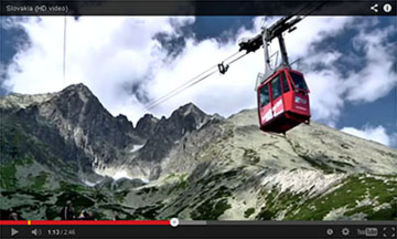The town of SPIŠSKÁ NOVÁ VES is located in the Hornádska kotlina basin and surrounded by the foothills of the Levočské vrchy from the north and the Spišško-gemerské rudohorie mountain range from the south.
SPIŠSKÁ NOVÁ VES (population 38,000) is the seat of the district of Spišská Nová Ves.
A great attraction held in Spišská Nová Ves in July is the Spiš Fair (Spišské výstavné trhy) by which the famous, almost six-hundred year long market tradition in Spišská Nová Ves continues. Tourists also like to visit the event called Spišská Nová Ves Town Days (Dni mesta Spišská Nová Ves) that is accompanied by the Craft Festival(Trh ľudových remesiel), which is held each August. In December, a traditional Christmas Fair (Vianočný trh) is organized in the town. Spišská Nová Ves is a cultural centre of the central part of the Spiš region, and there are many planned occasions and events held in the town basically all year long.
HISTORY
The earliest Slavic findings from the town territory are from the 8th century. Six regular settlements are known from the 9th and the 10th centuries. The medieval town originated on this river terrace in the course of the 13th century and was established through the integration of the most important Slavic village called Iglov and a new village of Saxon settlers. The first written record of the town of Spišská Nová Ves dates to 1268 when it was referred to as Villa Nova. In late 13th and early 14th century the town constructed fortifications that rank among the largest in Slovakia. The decay thereof dates back to the first half of the 19th century. In the years 1412-1772 Spišská Nová Ves was included in the pledge of the Spiš cities to the Polish ruler Ladislaus Jagiellon. After 1871 the dynamic economic development of the city was stimulated by the Košice-Bohumín railway track.
MONUMENTS
The lenticular square of Spisská Nová Ves, counted among the most beautiful in Slovakia and the longest of this kind in Europe, is the most striking feature of the town. The dominating part of the square is that of the Roman-Catholic parishchurch of the Virgin Mary's Ascension. Its massive basilica with three aisles has a prominent neo-Gothic tower from the late 19th century, which at 87 m is the tallest in Slovakia.
On the northern side of the square opposite the parish church, there is a large building that also comprises the Levočská brána gate - Province House. Originally it was the Town Hall, nowadays the building houses the Spiš Museum.
Built in the classicist style in years 1777 - 1779, the Town Hall of Spišská Nová Ves stands in the centre of the square. The Classicist building of the Lutheran Churchfrom 1790 - 1796 is situated next to the Town Hall.
The former hospital church, nowadays known as the Slovak Church – Church of Virgin Mary's Immaculate Conception is located near the square - in the area of terraced houses on Levočská Street. The town is also the seat of other cultural institution such as the Gallery of Artists of Spiš, the Spiš Cultural Centre and theSpiš Library. The building of Reduta at the end of the square houses the Spiš Theatre and the Town Cultural Centre.
RECOMMENDED TRIP
In Spišská Nová Ves (in the so-called Madaras Park) you can find the newest and smallest, though according to many of its visitors, the nicest Zoological Garden in Slovakia. It stretches out on the area of 8 hectares and you can see more than 230 animals (77 species) there.
Spišská Nová Ves and the villages situated west of the town constitute the entrance "gate" to the National Park of Slovenský raj (The Slovak Paradise) from the north. They are the starting point for trips to the area which is very attractive for tourists with the wonderful landscape where deep forests alternate with karst plains, canyons and caves. In addition, there are also remarkable monuments that document the early history of the settlement in Spiš and in Slovakia as a whole.
Source: Vydavateľstvo Dajama, Mesto Spišská Nová Ves






